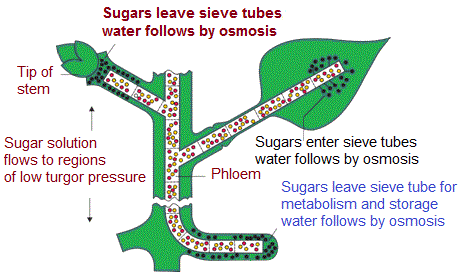Transportation in plants
Water, variety of inorganic elements and salts taken up by the roots has to reach all parts of the plant, up to the very tip of the growing stem.
The photosynthates or food synthesised by the leaves have also to be moved to all parts including the root tips embedded deep inside the soil. Movement across short distances.
The transportation takes place in plant at thee levels as follows:
1. Transport substance from one cell to another.
2. Long-Distance transport of sap within phloem and xylem.
3. Release and uptake of solute and water by individual cells.

The movement of these nutrients from environment into the plant as well as from one plant cell to another plant cell essentially involves movement cross a cell membrane. Transport across cell membrane can be through diffusion, facilitated transport. Water and minerals absorbed by roots are transported by xylem and the organic material synthesised in the leaves is transported to other parts of plant through phloem.
Passive transport (diffusion, osmosis) and active transport are the two modes of nutrient transport across cell membranes in living organisms.
In passive transport, nutrients move across the membrane by diffusion without any use of energy as it is always down the concentration gradient and hence entropy driven. This diffusion of substances depends on their size, solubility in water or organic solvents.
Osmosis is the special type of diffusion of water across a selectively permeable membrane which depends on pressure gradient and concentration gradient.
In active transport, energy in the form of ATP is utilised to pump molecules against a concentration gradient across membranes. Water potential is the potential energy of water molecules which helps in the movement of water. It is determined by solute potential and pressure potential. The osmotic behaviour of cells depends on the surrounding solution. If the surrounding solution of the cell is hypertonic, it gets plasmolysed.
The absorption of water by seeds and drywood takes place by a special type of diffusion called imbibition. In higher plants, there is a vascular system comprising of xylem and phloem, responsible for translocation. Water minerals and food cannot be moved within the body of a plant by diffusion alone. They are therefore, transported by a mass flow system – movement of substance in bulk from one point to another as a result of pressure differences between the two points.
Water absorbed by root hairs moves into the root tissue by two distinct pathways. Various ions, and water from soil can be transported upto a small height in stems by root pressure. Transpiration pull model is the most acceptable to explain the transport of water. Transpiration is the loss of water in the form of vapours from the plant parts through stomata. Temperature, light, humidity, wind speed and number of stomata affect the rate of transpiration.
Excess water is also removed through tips of leaves of plants by guttation.
Phloem is responsible for transport of food (primarily) sucrose from the source to the sink. The translocation in phloem is bi-directional.
Xylem is a long, non-living tube running from the roots to the leaves through the stem. The water is absorbed by the root hair and undergoes cell to cell movement by osmosis until it reaches the xylem. This water is then transported through the xylem vessels to the leaves and is evaporated by the process of transpiration. The xylem is composed of elongated cells like the phloem and especially accountable for transporting water to all the plant parts from the roots. Because xylem serve an important function therefore every tree have a lot of xylem tissues.
Phloem is responsible for translocation of nutrients and sugar like carbohydrates, produced by the leaves to areas of the plant that are metabolically active. It is made up of living cells. The cells walls of these cells form small holes at the ends of the cells known as sieve plates.
